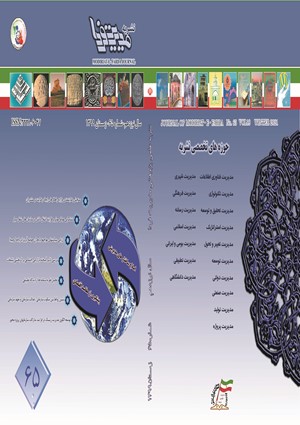شناسایی و اولویت بندی انتظارات کاربران بانکداری اینترنتی با استفاده از تصمیم گیری چندمعیاره فازی
محورهای موضوعی :مسعود موسوی نژاد 1 , علیرضا شهرکی 2
1 - دانشگاه سیستان و بلوچستان
2 - دانشگاه سیستان و بلوچستان
کلید واژه: تحلیل سلسله مراتبی فازی FAHP رتبه بندی بانک,
چکیده مقاله :
امروزه با شتاب گرفتن روند توسعه فناوری ارتباطات و اطلاعات در سطح جهان و نياز تجارت به حضور بانک ها برای انتقال منابع مالي، اهمیت بکارگیری بانكداري اينترنتي بیش از پیش نمایان شده است. در حال حاضر به نظر مي رسد بانک ها بايد به بانكداري اينترنتي که يكي از سرشاخه هاي مهم بانكداري الكترونيک است، توجه شگرفی نشان داده و براي فرهنگ سازي و آموزش اين روش، گام هاي مؤثرتري بردارند. پژوهش حاضر با هدف شناسایی و اولویت بندی انتظارات کاربران بانکداری اینترنتی و رتبه بندی بانک ها بر اساس انتظارات با روش های تصمیم گیری چندمعیاره فازی انجام شده است. پس از مطالعات کتابخانه ای و نظرات خبرگان، انتظارات کاربران شناسایی شده و پرسشنامه ای بر اساس روش فرایند تحلیل سلسله مراتبی طراحی شد و نظرات 20 نفر از خبرگان جمع آوری گردید. نتایج این روش بیانگر آن بود که به ترتیب معیارهای سهولت استفاده، دسترسی و خدمات حرفه ای دارای اوزان بیشتری هستند و در رتبه اول تا سوم قرار گرفتند. بنابراین با توجه به محصول اولویت بندی انتظارات کاربران بانکداری اینترنتی، می توان اولویت های مختلف مشتریان را مورد تحلیل و بررسی قرار داد و خدمات را بر اساس نیازهای آنان طراحی و مدیریت نمود.
Nowadays, with the acceleration of the development of information and communication technology in the world and the need for trade in the presence of banks to transfer financial resources, the importance of using Internet banking has become more prominent. At the moment, it seems that banks have to pay close attention to Internet banking, one of the important branches of electronic banking, and to take more effective steps towards the culture and education of this method. The purpose of this study was to identify and prioritize the expectations of internet banking users and rank the banks based on expectations by fuzzy multi-criteria decision-making methods. Following library studies and expert opinions, user expectations were identified and a questionnaire was developed based on the hierarchical analysis process, and the views of 20 experts were gathered. The results of this method indicate that the criteria for ease of use, access, and professional services have more weights and ranked first to third. Therefore, with respect to the product, prioritizing the expectations of Internet banking users, it is possible to analyze and prioritize different customers, and design and manage the services according to their needs.
Akinci, S., S. Aksoy, and E. Atilgan., 2004. Adoption of Internet banking among sophisticated consumer segments in an
advanced developing country. Vol. 22.. 212-232
Blythe, J., 2008. Essentials of Marketing (Fourth ed). Pearson Education Elaalem, M., 2013. A Comparison of Parametric and Fuzzy Multi-Criteria Methods for Evaluating Land Suitability for
Olive in Jeffara Plain of Libya. APCBEE Procedia. 5. 405-409 Hanafizadeh, P., Behboudi, M., Abedini Koshksaray, A., Jalilvand Shirkhani Tabar, M., 2014. Mobile-banking adoption by
Iranian bank clients. Telematics and Informatics, 31(1). 62-78. Jin, J., P. Ji, and R. Gu,. 2016. Identifying comparative customer requirements from product online reviews for
competitor analysis. Engineering Applications of Artificial Intelligence. 49. P:61-73 Joseph, M. and G. Stone,. 2003. An Empirical Evaluation of US Bank Customer Perceptions of the Impact of Technology
on Service Delivery in the Banking Sector. Vol. 31. 202-190 Minjoon, J. and C. Shaohan,. 2001. The key determinants of Internet banking service quality: a content analysis.
International Journal of Bank Marketing. 19(7). 276-291 Mosadeghi, R., et al., 2015. Comparison of Fuzzy-AHP and AHP in a spatial multi-criteria decision making model for
urban land-use planning. Computers, Environment and Urban Systems. 49. 54-65 Nemati, M., et al., 2015. Designing Interactive Model of Perceived Security and Citizen Trust and Their Impacts on the
Acceptance of Internet Banking (The Case of Khoy City). Journal of Urban Economics and Management. 3(11). 137-
152 Safarpour, M., 2016. Identification and Ranking the Barriers to Adoption and Development of Electronic Banking in
Iran. Procedia Economics and Finance. 36. 374-380 Santouridis, I. and M. Kyritsi, 2014. Investigating the Determinants of Internet Banking Adoption in Greece. Procedia
Economics and Finance. 9. 501-510 Yusuf Dauda, S. and J. Lee, 2015. Technology adoption: A conjoint analysis of consumers׳ preference on future online
banking services. Information Systems. 53. 1-15 بابایی میبدی، ح؛ حاجی رحیمیان، ا؛ محمدی مقدم، م. 1396. اولویت بندی عوامل موثر بر کیفیت سیستم های ارائه دهنده خدمات بانکداری اینترنتی موردمطالعه: بانک رفاه. دومین کنفرانس ملی مدیریت راهبردی خدمات
حبیبی، آرش؛ ایزدیار، صدیقه؛ سرافرازی، اعظم. 1393. تصمیمگیری چندمعیاره فازی، انتشارات کتیبه گیل
حساس یگانه، ی؛ طباطبایی نسب، م. 2014. مدل سنجش انتظارات مشتریان صنعت بانکداری برمبنای ادراک آنان. کاوش¬های مدیریت بازرگانی. 6(12): 115-136
صفرزاده، ح؛ فروتن، م. 1390. شناسایی عوامل موثر بر پذيرش بانكداري اينترنتي. دوماهنامه دانشور رفتار. شماره 50، 433-450
عبدالوند، م؛ عبدالعظیمی، ح. 2012. بررسی عوامل موثر بر پذیرش بانکداری اینترنتی از تلفیق دو مدل "پذیرش تکنولوژی" و "تئوری رفتار برنامه ریزی شده" با ریسک و سود ادراک شده توسط مصرف کننده. مدیریت بازاریابی. 7(شماره 15): 1-14
لگزیان، م؛ یغما، س. 1389. شناسايي و تعيين ميزان تاثير عوامل موثر بر پذيرش بانک داري الکترونيک از ديدگاه مشتريان. دانش و توسعه. دوره 17، شماره 34، 146-168
مقدادیان، ف؛ لشکری، م؛ داودی، ع. 1392. اولویت بندی عوامل موثر بر استفاده مشتریان از خدمات الكترونیكی بانك ها با استفاده از سیستم فازی. پژوهشنامه اقتصادی. سال سيزدهم(48): 29
نقی نتاج، ح. 1390. مزایای بانكداری اینترنتی. تازه های اقتصاد. سال نهم(134): 28-31
نیک بخش تهرانی، م؛ آذرصابری، م. 1381. آشنایی با تجارت الکترونیک و زیرساخت های آنE-Commerce.: انستیتو ایزایران
هاشمیان، م؛ عیسایی، م؛ طباطبایی، ف؛ میکائیلی، م. 2012. عوامل مؤثر بر پذیرش ابزارهای بانکداری الکترونیک از سوی مشتریان (پیمایشی دربارهی بانک سامان). فصلنامه علمی-پژوهشی مدیریت فناوری اطلاعات. 4(11): 155-174


